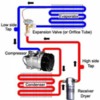For you A/C gurus out there...Does it matter if the fatter"larger" a/c hose picks up from the bottom of the A/c condensor? On a stock condensor it picks up off the top of the condensor. My new aftermarket condensor came with the fittings swapped. Stock=fat-top/small bottom.
Aftermarket=fat bottom-small top.
I hope that was clear....
Original Post


